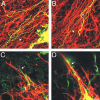Astrocyte-associated fibronectin is critical for axonal regeneration in adult white matter
- PMID: 15496664
- PMCID: PMC6730112
- DOI: 10.1523/JNEUROSCI.2120-04.2004
Astrocyte-associated fibronectin is critical for axonal regeneration in adult white matter
Abstract
Although it has been suggested that astroglia guide pioneering axons during development, the cellular and molecular substrates that direct axon regeneration in adult white matter have not been elucidated. We show that although adult cortical neurons were only able to elaborate very short, highly branched, dendritic-like processes when seeded onto organotypic slice cultures of postnatal day 35 (P35) rat brain containing the corpus callosum, adult dorsal root ganglion (DRG) neurons were able to regenerate lengthy axons within the reactive glial environment of this degenerating white matter tract. The callosum in both P35 slices and adult rat brain was rich in fibronectin, but not laminin. Furthermore, the fibronectin was intimately associated with the intratract astrocytes. Blockade of fibronectin function in situ with an anti-fibronectin antibody dramatically decreased outgrowth of DRG neurites, suggesting that fibronectin plays an important role in axon regeneration in mature white matter. The critical interaction between regrowing axons and astroglial-associated fibronectin in white matter may be an additional factor to consider when trying to understand regeneration failure and devising strategies to promote regeneration.
Figures








References
-
- Ard MD, Bunge MB, Wood PM, Schachner M, Bunge RP (1991) Retinal neurite growth on astrocytes is not modified by extracellular matrix, anti-L1 antibody, or oligodendrocytes. Glia 4: 70-82. - PubMed
-
- Baron-Van Evercooren A, Kleinman HK, Ohno S, Marangos P, Schwartz JP, Dubois-Dalcq ME (1982) Nerve growth factor, laminin, and fibronectin promote neurite growth in human fetal sensory ganglia cultures. J Neurosci Res 8: 179-193. - PubMed
Publication types
MeSH terms
Substances
Grants and funding
LinkOut - more resources
Full Text Sources
Other Literature Sources
Research Materials
